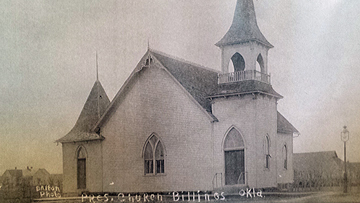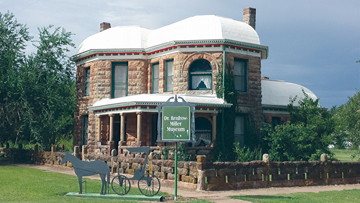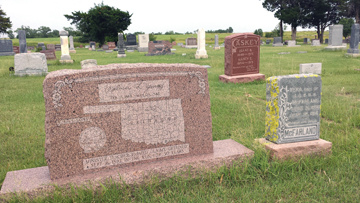You have free articles remaining this month.
Subscribe to the RP Witness for full access to new articles and the complete archives.
“Oh, I’m a Reformed Presbyterian.” We stood stunned inside the Renfrow-Miller Museum in Billings, Okla. This town had lost its Reformed Presbyterian Church on June 3, 1926, many years before this lady was born. How could she consider herself a Reformed Presbyterian?
She explained. “My grandfather was J. C. Young. I am related to the McFarlands and Parnells.” This lady had the pedigree to be a blue-blood Covenanter. Yet she was a lifelong Methodist. This prompts a bigger question: What should be made of Covenanter ghost towns like Billings, Okla.? What should Reformed Presbyterians think of deceased congregations?
A sound doctrine of the church has the answer—the “holy catholic church” of the Apostle’s Creed. Our ghost towns remind us of the true nature of the Church: timeless and global, universal in space and time. A visit to Billings recalls that kingdom work never fails; the Church always grows and thrives, even when the local congregation falters or fails. The hope of Christian ministry transcends the quantifiable health of the weekly gathering.
The town of Billings literally began with a bang. At noon on Sept. 16, 1893, a cannon roared and waves of people raced over the sun-drenched prairie of the Cherokee Strip. Amid the dust rode Covenanters hoping for land near each other. Seven families with the last names of Henderson, McFarland, Young, and Chestnut succeeded. They originally staked property along the Red Rock Creek, but their Sabbath convictions kept them from filing in a timely manner. All but two had their claims jumped. The McFarlands and Youngs (4 families in all) refiled on upland claims approximately 4 miles northwest of the Red Rock Creek land. The seventh family, a Henderson clan, providentially took possession of an unwanted claim immediately adjacent to the other Henderson property. The Covenanter community had their homesteads.
The upland Covenanters did not regret their relocation from Red Rock Creek to the upland claims, since the brand new town grew up on the Youngs’ property. When the train came through, they and the McFarlands enjoyed greater access to imported goods. The Youngs sold 40 acres for the town to begin then sold another 40 acres for the town to expand. After a while, they sold a final 40 acres to accommodate the growing population. Living in the vicinity of commerce also put these four families at the center of the church and civic experience. Worship was held in their homes until Billings built a school; then the congregation used the school building.
In 1900, the Billings RP Church was added to the RPCNA with three elders and three deacons but no pastor. G. R. McBurney had preached and ministered for a little more than a year prior to 1900, and W. C. Paden served as stated supply from 1901–09, when H. G. Foster was installed as pastor. The Isaac Caskey family of Clarinda, Iowa, came in 1902, greatly strengthening the work with their 12 children. The congregation rejoiced when their building on S. Pearl Street was completed in 1904. The traditional prairie church building cost $1,600 to build. Pews, a “mothers’ room,” and a basement were added in 1910 with a grant from Synod. After Rev. Foster moved on, J. M. Rutherford was ordained and installed on Nov. 6, 1914.
In their first two decades, Billings RPC enjoyed growth and stability, even reaching 100 students in the Sabbath school. But something stirred within the congregation. A. J. McFarland cryptically writes, “The old demon of jealousy could not be kept out … there was decay at the roots.” Old tales and informed conjectures remain the only insights to the fatal condition in Billings. The Minutes of Synod make no mention of the troubles. Whatever the leading events may have been, 1920 proved the critical year. That autumn J. M. Rutherford resigned from the congregation without a new call awaiting him, and the McFarlands led a party of 11 to Orlando, Fla. Communicant membership in Billings fell from 44 in 1920 to 20 in 1922. The remnant whittled down to 6 in 1926, when at last the congregation closed and the building sold to the American Legion. The remaining Covenanters, mostly Youngs, lingered among the residents of Billings down to this day. In Union Cemetery, 2.5 miles southeast of town, is found graves of Vera McFarland, Della Paden, and the Caskeys, Youngs, Chestnuts, and Hendersons. These saints dead in Billings still worship; the Church has not lost them. Christians can still sing psalms with them; they just cannot hear them. Consider that those who sang psalms in Billings in true faith sing them still. Consider that the prairies of Billings will hear those songs again when the dead rise incorruptible.
Although the church building is gone, church members like Bob McFarland, who descended from Billings, continue its legacy of faith. J. C. McFarland’s grandson served Jesus as the Midwest Presbytery’s regional home missionary, assisting in over half a dozen church plants within that presbytery. Consider that the men who were disappointed by their church plant in Billings went on to contribute, through their descendants, to the works in Stillwater and Enid. And families who failed to establish a lasting local congregation in Oklahoma, went on to plant the church in Orlando that remains. This encourages us to consider the generations yet to be who will benefit from the struggles of the present.
The kingdom of God did not falter even when the Billings congregation failed. Although branches may wither and some may be snipped off, the vine God brought up out of bondage has been rooted deeply; it flourishes and fills the land (Ps. 80). Lift your gaze from time to time and see the vast expanse of Christ’s church. Never measure your ministry by what you see immediately in front of you. Consider our ghost towns, remembering that Christ built His church there and hell could not withstand its advance.


